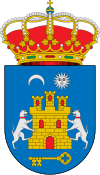Alanís
| Alanís, Spain | |||
|---|---|---|---|
|
|||
| Coordinates: 38°02′16.7″N 5°42′49″W / 38.037972°N 5.71361°W | |||
| Country | Spain | ||
| Province | Seville | ||
| Municipality | Alanís | ||
| Area | |||
| • Total | 280.19 km2 (108.18 sq mi) | ||
| Elevation | 660 m (2,170 ft) | ||
| Population (2012) | |||
| • Total | 1,858 | ||
| • Density | 6.6/km2 (17/sq mi) | ||
| Time zone | CET (UTC+1) | ||
| • Summer (DST) | CEST (UTC+2) | ||
| Postal code | 41380 | ||
| Website | Official website | ||
Alanís is a municipality in Seville. In 2005 it had a population of 1,937. It has an area of 280 square kilometers and a population density of 6.9 people per square kilometer. It is located at an altitude of 660 meters and is 106 kilometers from Seville.
The population has been steadily decreasing from 2,108 in 1996 to its current level.
Alanís has several monuments.
Alania and Alanis as descendants of the Alans. The Alans (also called alauni or halani) were an ethnic group of Iranian origin included in the family of the Sarmatians, very warlike nomadic pastoralists from different backgrounds, who speak the Iranian language and shared with them the same culture in many ways. Flavius Josephus (37-94), writing in his Jewish War (Book 7, Chapter 8.4) how Alans (whom he calls The Scythian tribe medieval Alania arose in the 8th century a consolidated Alan kingdom, called in the chronicles of the time Alania, in the northern Caucasus Mountains, roughly in what today is Circassia and North Ossetia-Alania
The Roman historian Ammianus Marcellinus argued that "almost all the Alani are tall and handsome. Their hair is usually blond and his eyes terribly fierce. " It also considered that the Alans were the ancient masagetos "iuxtaque Massagetae Halani et Sargetae ',' per Alban et Massagetas, nunc appellamus quos Alans," "Halanos pervenit, veteres Massagetas."
The Massagetae (Massagetae, Μασσαγέται Greek) were a nomadic people who lived among the Sea of Aral and the Caspian Sea during antiquity. According to Herodotus, Cyrus II the Great of Persia was killed during a battle against the Massagetae, led by Queen Tomiris. The name means great Scythian masageta Ma equals large and equals sagetas Scythians. Descendants of the Scythians Scythians (Greek: Σκύθης, Σκύθοι) was the name given in antiquity to members of a people or group of peoples of Iranian origin characterized by a culture based on nomadic herding and breeding horses mounted. In classical antiquity, the Pontic Steppe Scythians dominated, which was named Escitia.1 His tongue would be the ancestor of modern Ossetian.
Terms in written sources
In ancient Chinese sources are called sai. In the Realms of India means were known by the name of shaka (the name is sometimes restricted to the northernmost of the tribes and other things). In Persian transliterated into Latin documents through the Greek are called Saces [sakes] and SacII [sakii] (Latin for the c is pronounced as k), also in Latin sármatae name is used (Sarmatian) and Greek scythae, although gave the name and the same would have been * alan-o * aryānah, this name has survived in modern Ossetian name Iron (otherwise it is considered that the current gentile people "Ossetian" is a variant of escita.2 In language Akkadian, the Scythians were the gugu (chiefs) of the land of Gugu Mat. In Sumerian language, the word gug means 'darkness' or 'darkness'. In Hebrew this word gug (or gog) means 'high' or 'ceiling' and figuratively 'superb'. In conclusion these meanings together are paraphrased as: the Scythians (Gog) coming from the dark land. In the Old Testament (the Bible) are described by various prophets: • Book of Ezekiel (in the literary Gog and Magog), Chapter 38, Book of Jeremiah • 4 and 5, Book of Zephaniah • 1 and 2.5 The Cherethites and Carians (Caria) potential allies of Gog. • Second Book of Maccabees 4, 47 In the New Testament, St. Paul named in the Epistle to the Colossians (3, 11). In the Book of Veles, where they were identified as Skiti.
...
Wikipedia



